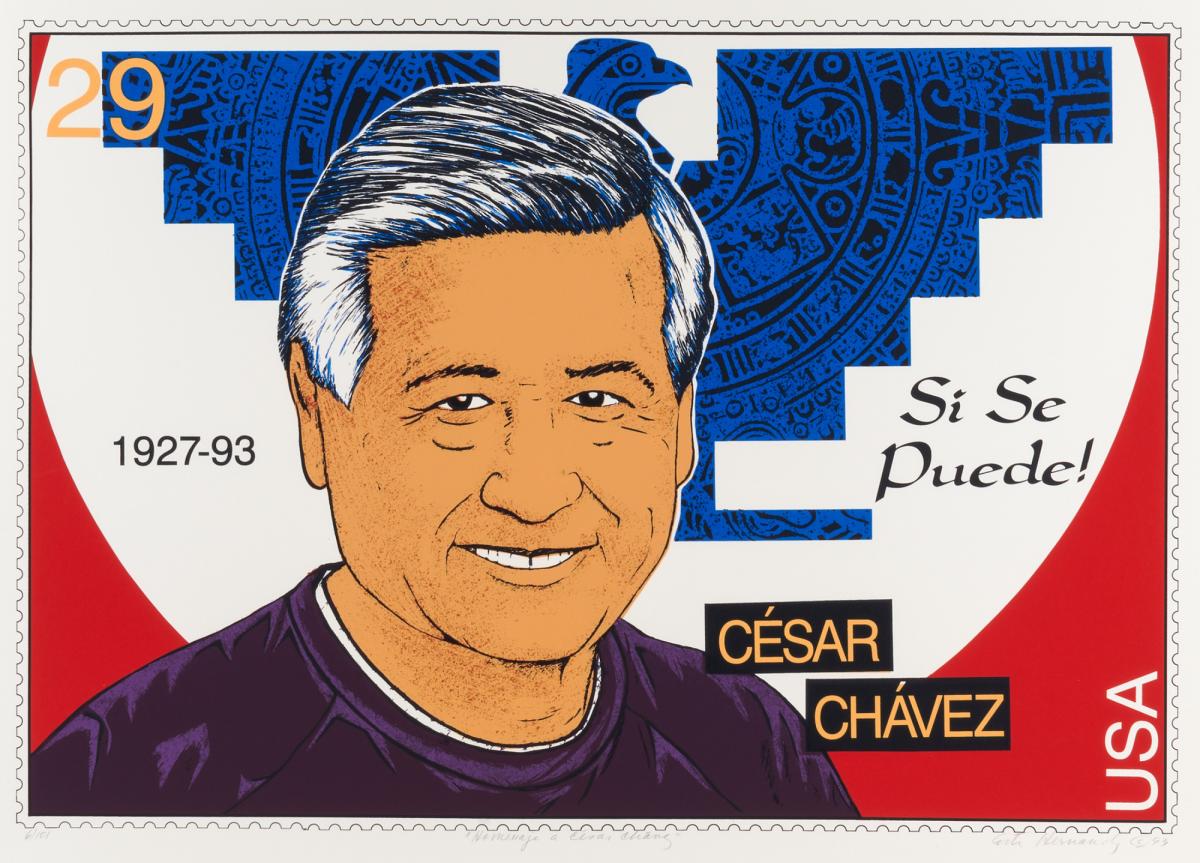
Ester Hernandez’s Homenaje a Cesar Chavez (Homage to Cesar Chavez), is a tribute to the noted civil rights and labor movement activist who, alongside celebrated activist Dolores Huerta, founded the National Farm Workers Association (NFWA) in 1962. The NFWA played a pivotal role in the labor movement as a precursor to the influential United Farm Workers of America (UFW), which became the first successful farm worker union in American history. Chavez’s legacy with the UFW is profound—he dedicated his life to advocating for fair wages, medical coverage, pension benefits, and humane living conditions for hundreds of thousands of farm workers—winning major legislative reforms for laborers. In recognition, his birthday on March 31 was declared a U.S. federal commemorative holiday in 2014 and became known as Cesar Chavez Day.
Chavez knew of the struggles, racism, and injustices facing agricultural workers firsthand. Born in 1927 outside of Yuma, Arizona, he left school after completing eighth grade to become a migrant farm worker—moving between fields, orchards, and vineyards throughout California to support his family. He later began efforts to organize farm workers in a movement that became known as La Causa. In 1965, Larry Itliong, a Filipino-American labor leader and organizer, encouraged Chavez and the NFWA to join the Delano Grape Strike he had organized with the predominantly Filipino Agricultural Workers Organizing Committee (AWOC). The Delano Grape Strike was a catalyst for a decade of organized actions, including large-scale boycotts against growers, bringing national attention to the struggles of farm workers. Strikes, boycotts, marches—and, later, fasts—highlighted Chavez’s commitment to the philosophy of nonviolent reform.
Chavez continually sought ways to unify laborers for the cause. Once the NFWA merged with the AWOC to form the United Farm Workers, Chavez tasked his younger brother, Richard Chavez, to design a logo for the new union. The brothers chose an image that would have been familiar to the Mexican workers, an Aztec-inspired eagle with its wings spread. As Cesar Chavez explained, “A symbol is an important thing. That is why we chose an Aztec eagle. It gives pride . . . When people see it, they know it means dignity.” Richard Chavez stylized the wings with squared edges so it would be easier for union members to recreate on homemade flags and signs. The UFW Eagle Mark went on to become a highly recognizable icon during union activities, strikes, boycotts, as well as legislative and political campaigns.
Like Cesar Chavez, artist Ester Hernandez also grew up in a family of farmworkers. She immersed herself in the farm workers movement and devoted much of her art to exposing the human and environmental impacts of California’s agribusiness. Hernandez created the portrait, Homenaje a Cesar Chavez, shortly after Chavez’s death in 1993 and follows an established tradition of Chicanx artists who use portraiture to highlight individuals committed to social justice activism.
In the style of a postage stamp, Hernandez’s screenprint awards Chavez the honor of being represented on a stamp ten years before the U.S. Postal Service released an official version. The UFW Eagle Mark fills the background. Filled with Indigenous Mexican symbols that echo an Aztec calendar, Hernandez deepens the symbol’s connection to its Indigenous roots. To the right of Chavez’s portrait, the words “Si se puede,” a popular rallying cry Chavez established as the motto of the UFW, mirrors the Chavez’s life dates and reminds the viewer that La Causa is still present and ongoing. Rather than using the traditional colors of the UFW—red, black, and white—Hernandez illustrates the image boldly in red, white, and blue. The colors, along with the stamp’s “USA” in the corner, signify that Chavez was not just important to the labor and Chicano communities, but firmly situates him as a pivotal figure in American history.



















